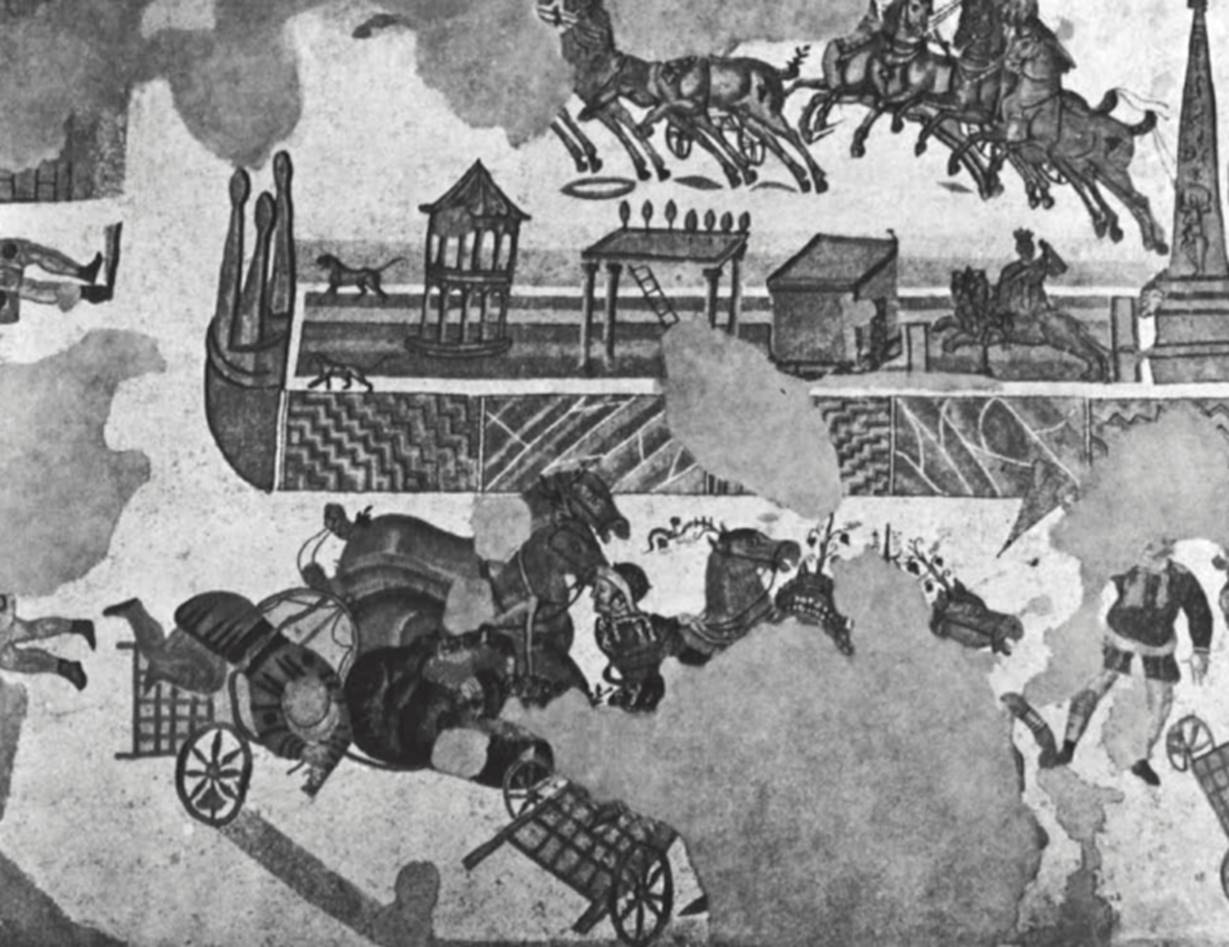Mosaic of a chariot race in the Circus Maximus. Piazza Armerina, Sicily, about 310-320. Marble and glass
The Villa of Maxentius at Piazza Armerina in Sicily (no. 105) contains the greatest single assemblage of floor mosaics surviving from classical antiquity. Although there has been some dispute about the date of the villa and its mosaics, recently most scholars have agreed on a date of 300-320 for the architecture and decoration and have associated the project with the reigns of Maximianus and his son, Maxentius. Despite the extent and complexity of the mosaics (about 3500 square meters), they were probably executed by mo- saicists brought in for the commission from Roman Africa.

The Great Chariot Race fills the corridor, placed between the principal entrance to the villa and the great peristyle, and functions as a "narthex" to the wing containing the baths. The mosaic represents in brilliant colors the excitement and dangers of the chariot race (see Sid. Apoll. Carm. 23.360 ff.), hotly contested by the four factions: red, white, green, and blue. A green charioteer has won the race and his chariot approaches the officials at the left, who trumpet his victorious arrival and hold out to him the palm of victory.
The race is set within an architectural environment that has been identified as the Circus Maximus in Rome, although not all of the topographical indications correspond to their actual positions in the city. Three temples are set at the far right at the curve of the circus, above the decorated railings: the temple of Jupiter Capitolinus is at the left, that of Roma Aeterna in the center, and at the right the temple of Hercules Victor, the only one to lie in the neighborhood of the Circus Maximus and important both to the charioteers and the dynasts, Maxentius and Maximianus (no. 100). At the other end of the circus the triumphal arch of Vespasian appears, badly damaged however, surrounded by luxuriously dressed spectators avidly watching the races. The spina is filled with statues, cult shrines, and markers that record the progress of the racers. Slightly to the left of center on the spina the cult statue of Magna Mater appears riding on her running lion, shown from the rear.
This view of the Magna Mater can only be understood if the mosaic has been composed as if the race were being watched by the emperor himself from the high tribunal, located at the side of the imperial palace on the Palatine in Rome overlooking the Circus Maximus. The proximity of palace to hippodrome characterizes several late Roman palace-villas and seems to imply a connection between the lord in his palace and the victories won in the circus. Such a symbol of power complements directly the imagery of the four circus factions, conventionally understood as a reference to the four seasons and the perpetual renewal of nature's bounty.
The circus mosaic must be studied in the context of the villa as a whole; motifs of the hunt, the contests of the stadium, and the exploits of Heracles form together with the circus an imagery of victory. But those images are so replete with references to the city of Rome and ancient Roman traditions, and to the dominance of Heracles, that only the careers of Maxentius and his father and their patronage of the pagan tradition at Rome seem sufficient to explain the program of the villa. Bibliography: Gentili, 1959, p. 19, figs. 1, 3, pis. vii-xiii; Rinaldi, 1964-1965; Carandini, 1967; Kahler, 1973; Settis, 1975.
Date added: 2025-07-10; views: 146;
